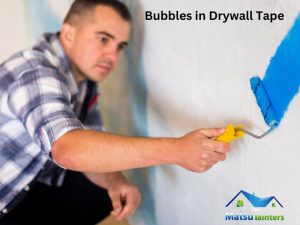
Ever stood back to admire your freshly finished drywall, only to notice annoying bubbles forming under the tape? It’s a frustrating problem, but it’s also a common one. The good news? It’s not hard to fix, and with a few simple steps, you can get rid of those bubbles and have your walls looking perfectly smooth in no time.
In this post, we’ll walk you through six easy steps to fix bubbles in drywall tape. Whether you’re tackling this problem for the first time or have dealt with it before, you’ll find the solution here. Plus, we’ll share some tips to make sure those bubbles never come back. And, if DIY isn’t your thing, Matsu Painters is just a call away to help!
Why Do Drywall Tape Bubbles Happen?
Before we get to the fix, let’s talk about why these bubbles happen in the first place. Knowing the cause can help prevent the issue in the future.
Drywall tape bubbles occur because air gets trapped underneath the tape. This usually happens due to:
- Uneven Application of Joint Compound: If the joint compound isn’t spread evenly, the tape won’t stick properly, trapping air.
- Moisture in the Room: High humidity or wet surfaces can prevent the joint compound from adhering correctly.
- Incomplete Drying: Rushing through the drying process can also cause issues, trapping moisture that leads to bubbles.
Now that we’ve got the “why” sorted, let’s move on to how you can fix it.
Step 1: Find All the Bubbled Areas
First things first, you need to locate the bubbles. Some might be obvious, but others can be sneakier. Run your hands gently along the taped seams of your drywall to feel for any raised areas. Mark these spots with a pencil so you don’t miss them later.
Be thorough here because you don’t want to leave any bubbles behind—otherwise, you’ll have to come back to it later.
Step 2: Cut Away the Bubbled Tape
Once you’ve marked all the bubbled areas, it’s time to remove the damaged tape. Using a sharp utility knife, carefully cut around the bubble. Be sure to cut through the tape but not too deep into the drywall itself. You only want to remove the section of tape that has the bubble.
Once you’ve made your cuts, gently peel the tape away from the wall. If the bubble is large, you may need to remove a bigger section. For small bubbles, a small cut should do the trick.
Pro Tip: Use smooth, steady motions when cutting to avoid accidentally damaging more of the tape or drywall.
Step 3: Sand the Surface Smooth
After removing the bubbled tape, you might have some rough or uneven edges left behind. Grab some fine-grit sandpaper (120-150 grit works great) and sand the area until it’s smooth. Be sure to remove any leftover adhesive or joint compound so that the surface is flat and ready for the new tape.
Once the area feels smooth to the touch, dust it off to get rid of any debris. This is key to ensuring the new tape sticks properly.
Step 4: Apply a Fresh Layer of Joint Compound
Now that the area is prepped, it’s time to apply a new joint compound. Start by mixing the compound to a smooth consistency. Using a drywall knife, spread a thin, even layer over the area where you removed the tape.
It’s important to extend the compound slightly beyond the edges of the damaged section to ensure good coverage. You don’t need a thick layer here—just enough to provide a smooth surface for the new tape.
Tip: A 6-inch drywall knife is the perfect size for spreading joint compound evenly.
Step 5: Place New Drywall Tape
While the compound is still wet, place a new piece of drywall tape over the area. Press the tape gently but firmly into the wet compound using your drywall knife. Start from one end and work your way to the other, pressing out any air bubbles as you go.
After the tape is in place, apply another thin layer of joint compound over it, making sure to smooth out the edges. This will blend the tape with the surrounding wall. Let it dry completely before moving on.
Pro Tip: Using mesh tape instead of paper tape can help reduce the chance of bubbles in the future.
Step 6: Sand and Finish
Once the compound is fully dry, it’s time for a final sanding. Use fine-grit sandpaper again to smooth out the surface. Be careful not to sand too aggressively—just enough to even everything out.
After sanding, clean off any dust, and you’re ready to paint! Start with a primer to seal the repaired area, then finish with your chosen paint color. You should now have a seamless, smooth finish.
Bonus Tips to Prevent Bubbles in the Future
Now that your drywall looks flawless, let’s keep it that way! Here are a few quick tips to prevent bubbles from coming back:
- Use Enough Joint Compound: Too little compound won’t hold the tape down, but too much can also cause bubbles. Aim for a smooth, thin layer.
- Work in a Low-Humidity Environment: Try to work in rooms with good ventilation or low humidity to ensure proper adhesion.
- Press Tape Firmly: Always press the tape down firmly to avoid trapping air underneath.
FAQs
Why Does My Drywall Tape Bubble?
Bubbles in drywall tape are often caused by improper application of the joint compound. If you don’t apply enough compound or spread it unevenly, air can get trapped under the tape, causing those annoying bubbles. Another common reason is working in a high-humidity environment, which can prevent the compound from drying properly, leading to bubbling.
Why Is My Drywall Patch Bubbling?
If you notice bubbling in a drywall patch, it’s likely due to moisture or air getting trapped beneath the surface. This can happen when the compound isn’t spread smoothly or if there’s leftover debris on the surface. Always clean and dry the area thoroughly before applying joint compound to avoid bubbles in patches.
What Causes Drywall Tape to Wrinkle?
Wrinkles in drywall tape occur when the tape isn’t pressed firmly enough into the wet joint compound, or if the compound is applied unevenly. Wrinkles can also happen if you apply a second coat of compound too quickly before the first layer has completely dried. Always give each layer time to dry thoroughly before applying more compound.
Conclusion
Fixing bubbles in drywall tape isn’t too complicated, but it does take some patience. By following these six steps, you’ll get your walls looking as good as new. However, if the thought of tackling this repair feels overwhelming, Matsu Painters can help. As a trusted local company in Matsu, we’re experts in drywall repair and more. Our team can take care of the job quickly and efficiently, leaving your home looking its best.
From drywall repairs to window installations and even snow removal, Matsu Painters has all your maintenance needs covered. Give us a call today to get started on your next project!
